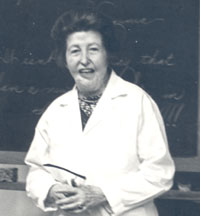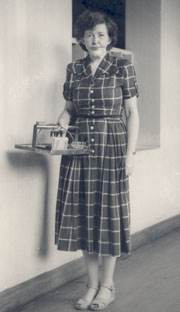Biographies
Virginia Minnich (1910-1996)
 |
| Virginia Minnich, 1972 |
Born on January 24, 1910, Virginia Minnich was raised on her family’s farm in southern Ohio. She attended primary school in a one-room schoolhouse and high school in nearby Zanesville. At the age of four Minnich was severely burned when her dress caught fire from a gas stove. Minnich endured almost 30 operations between 1915 and 1952 to correct the disfigurement. Though teachers and associates often discouraged Minnich from pursuing careers that would put her in contact with too many people, Minnich was determined to prove to herself and others what she could accomplish.
Economic conditions forced Virginia to delay starting college until 1932, when one of her older sisters was able to lend her the tuition money. She earned a bachelor’s degree in Home Economics in 1937, and a master’s degree in Nutrition from Iowa State University. During her senior year of college, Minnich worked in the lab of Dr. Carl V. Moore, who was a research fellow in the Department of Hematology at Ohio State. Two years later, when Moore was joining the faculty of Washington University to establish a Division of Hematology in the School of Medicine, he wrote Virginia Minnich and offered her a job as technician. Minnich accepted the position and subsequently spent her entire professional career at Washington University.
 |
| Virginia Minnich in her lab, 1968 |
In 1939 Minnich was promoted to research assistant, a title which she kept until 1954 when she became a research associate. Four years later she became a research assistant professor, and in 1963 a research associate professor. In 1974, Minnich was made a professor of Medicine, the first person to achieve that rank at Washington University with neither a medical degree nor a Ph.D. William Woods College in Fulton, Missouri awarded Minnich with an honorary doctor of science degree in 1972. Minnich became professor emeritus in 1978. In addition to her position at Washington University, Minnich was assistant (later associate) director of Hematology at Barnes Hospital in St. Louis, from 1975 until her retirement in the mid-1980s.
Virginia Minnich published more than 45 scientific papers and authored 19 abstracts. Her research interests were diverse, focusing on iron metabolism, vitamins, platelets, abnormal hemoglobins, pica, thalassemia, glutathione, and carcinogens. Her work led to the discovery of hemoglobin E and the elucidation of the glutathionine synthesis pathway.
Minnich was a noted teacher, training sophomore medical students, hematology fellows, house staff members, and lab technicians. As an offshoot of her teaching, Minnich developed a series of audiovisual materials on all aspects of the morphology of the peripheral blood films and bone marrow, which were used by hematologists worldwide. In the early 1980s the American Society of Clinical Pathologists published Minnich’s 10-part audio-visual course in morphologic hematology.
 |
| Virginia Minnich, Thailand, 1951 |
Minnich traveled extensively – both to scientific conferences in such cities as Santiago, Lima, Munich, Stockholm, and Sydney, and for pleasure. In 1960 Minnich took 6 months off for a trip around the world (with a stop in Tokyo to present a paper to the Eighth International Congress of Hematology). Her reputation as a teacher and accomplished morphologist led to her being asked to help establish hematology labs around the world. In 1945 Minnich set up a lab at the University of Havana. In 1951 she went to Siriraj Hospital in Bangkok, Thailand as part of an exchange program between the hospital and Washington University. While there she taught and began her noted research on thalassemia and hemoglobinopathies. Minnich returned to Bangkok for several months in 1954 to continue her research. In 1964 Minnich went to Turkey as a Fullbright-Hayes fellow and helped to establish a hematology laboratory in the Department of Pediatrics at the University of Ankara. The University later named it the Virginia Minnich Hematology Laboratory in honor of her work there.
After her retirement in 1984, Virginia Minnich moved to Florida, where she died in 1996. Upon her death, the Division of Hematology-Oncology established the Virginia Minnich Memorial Visiting Professorship in Hematology in her honor. Minnich willed her estate to the Washington University School of Medicine to be used for student scholarships.
Related Links:
Return to WUMC Faculty/Staff (Biographies)
Return to All Biographies
Back to Top
